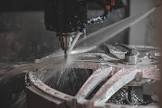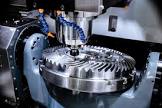🔧 Challenges in CNC Machining for Precision Machining Shops
Precision machining shops operate in a high-stakes environment where even minor deviations can lead to costly rework or part rejection. Let’s examine the most pressing challenges:
1. Maintaining Ultra-Tight Tolerances
- Modern industries (aerospace, medical, automotive) demand tolerances as tight as ±0.0001 inches.
- Thermal expansion, tool wear, and machine calibration can compromise accuracy.
2. Material Variability and Machinability
- Hardened steels, titanium, and composites require specialized tooling and cutting strategies.
- Inconsistent material batches can lead to unexpected tool breakage or surface finish issues.
3. Tool Wear and Breakage
- High-speed machining accelerates tool degradation, increasing downtime and costs.
- Poor chip evacuation or incorrect feeds/speeds exacerbate wear.
4. Production Efficiency & Lead Time Pressures
- Balancing speed with precision is a constant struggle.
- Complex geometries often require multiple setups, increasing cycle times.
✅ Innovative Solutions for Precision Machining Shops
1. Advanced CNC Machine Capabilities
- 5-axis machining reduces setups and improves accuracy for complex parts.
- High-speed spindles (20,000+ RPM) enable smoother finishes on tough materials.
2. Smart Tooling Strategies
- Coated carbide tools (TiAlN, diamond-coated) extend tool life in abrasive materials.
- Predictive maintenance using IoT sensors monitors tool wear in real time.
3. Optimized Cutting Parameters
| Material | Recommended SFM (Surface Feet/Min) | Feed Rate (IPR) |
|---|---|---|
| Aluminum 6061 | 800-1,500 | 0.004-0.012 |
| Stainless Steel 304 | 100-300 | 0.003-0.008 |
| Titanium (Grade 5) | 60-150 | 0.002-0.006 |
| – Adaptive machining software dynamically adjusts feeds/speeds for optimal performance. | ||
| ### 4. Rigorous Quality Control | ||
| – In-process inspection (CMM, laser scanning) catches deviations early. | ||
| – Statistical Process Control (SPC) tracks trends to prevent defects. | ||
| — | ||
 |
||
| ## 📊 Best Practices for Precision Machining Shops | ||
 |
||
| To stay ahead, adopt these proven strategies: | ||
| ### 1. Invest in Workforce Training | ||
| – Skilled machinists who understand GD&T (Geometric Dimensioning & Tolerancing) are invaluable. | ||
| – Continuous training on new CNC technologies keeps your shop competitive. | ||
| ### 2. Leverage Automation | ||
| – Robotic part loading/unloading reduces idle time between cycles. | ||
| – Lights-out machining maximizes productivity for high-volume runs. | ||
| ### 3. Partner with Material Experts | ||
| – Work closely with suppliers to ensure consistent alloy properties and certifications. | ||
| ### 4. Adopt Lean Manufacturing Principles | ||
| – Value stream mapping identifies waste in workflows. | ||
| – Just-in-Time (JIT) inventory minimizes stockpiling costly materials. | ||
| — | ||
| ## 🔮 The Future of Precision Machining | ||
| Emerging trends shaping the industry: | ||
| – AI-driven machining optimizes tool paths in real time. | ||
| – Additive + subtractive hybrid manufacturing for complex, lightweight components. | ||
| – Sustainable machining with reduced coolant waste and energy-efficient spindles. | ||
| — | ||
| ## Final Thoughts | ||
| Precision machining shops thrive by embracing innovation, refining processes, and investing in the right technology. By addressing these challenges head-on, manufacturers can achieve higher accuracy, faster throughput, and superior part quality—key differentiators in today’s market. | ||
| Need a reliable precision machining partner? [Contact us] to discuss your project requirements. | ||
| — | ||
| This article balances technical depth with actionable insights, ensuring it resonates with B2B readers while maintaining strong SEO performance for “precision machining shop.” Let me know if you’d like any refinements! |
